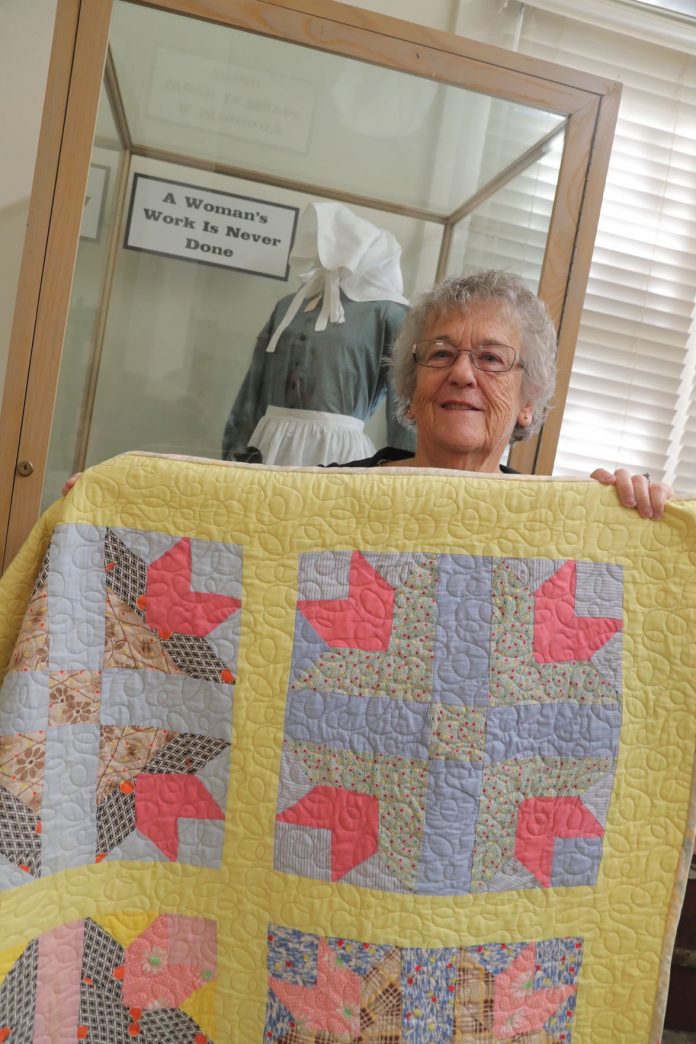
Most objects can perform a function or purpose, but only a rare few can serve as a portal into the past. What if a piece of fabric could take you back in time?
During the past year, several Gilroy Museum volunteers and local quilting club members have put their heart and soul into the completion of an unfinished quilt top. This quilt provides a unique perspective into the life of a local Gilroy resident, the late Gertie Dotson Phillips.
“It started off with my neighbour across the street,” Linda Elia, a museum volunteer, says. “It was her mother-in-law’s quilt top. She had a bunch of them, so I took the tops and I’ve had them for a couple of years now.”
It was only last year that Elia decided to start a passion project to finish the quilt with several other women. She enlisted the help of Barbara Heno, Edith Eddy, June Bell and Linda Williams, who all contributed in different ways to the completion of the quilt. Williams, owner of The Nimble Thimble Quilt Shop and a Gilroy Museum Historical Society member, donated the backing for the quilt.
Elia says the squares were created in the design of the Wild Goose Chase pattern popular during the 1930s and ’40s. It’s unknown why the quilt was never completed. However, Elia knows it was hand-pieced, except for the border. That was sewed on by machines.
“I think it was quilted in the ’30s and ’40s because a lot of that fabric was made out of flour sacks,” she says. “We can actually see some of those prints on [the quilt’s] fabric.”
Elia explains that many people didn’t have money to buy materials for quilts in the early 20th century. As a measure of resourcefulness, empty flour sacks were substituted and utilized instead of relegating them to the trash bin. The vintage quilt will be raffled off in early December, proceeds of which will go toward the Gilroy Museum.
“I’m interested in quilting and I’m interested in history,” Elia says. “I love history. I was born and raised in Gilroy, so that makes it even more important for me to do something for the city of Gilroy.”
Carol Dotson, Gertie Dotson Phillips’s daughter-in-law, describes her as a “very quiet” woman who lived into her late 90s.
“She quilted her whole life,” Dotson says. “I think that woman worked her whole life, most of it at the cannery.”
Dotson explains how her mother-in-law worked at the Filice and Perrelli Cannery that was located on the east side of Gilroy, where housing units now stand.
“They would go back to Arkansas for six weeks and that’s when they would sit down every evening and do quilts,” she says. “She was born and raised in Arkansas and then moved to California, but lived most of her adult life in Gilroy.”
“Quilting, in general, was a social outlet for people because they had scraps of material and didn’t have other entertainment,” Connie Rogers, a historian with the Gilroy Museum, explains. “It was a way for women to get together to exchange news and views with other women within their community. It’s a time-honored occupation.”
While some people might not understand the relevance a quilt might have to the history or people of Gilroy, Rogers points out how something as simple as fabric can transcend time through emotion.
“There are very few things that are made by hand anymore,” she says. “It’s a measure of people’s devotion and involvement that they would do something like this.”
The quilt will be raffled off Dec. 7 at the museum’s annual volunteer appreciation lunch. Tickets are $2 for 1, or $10 for 6 and available for purchase at the Gilroy Museum, 195 Fifth St, Gilroy, or The Nimble Thimble, 7455 Monterey St, Gilroy, where the quilt is on display. Proceeds will go to the Gilroy Museum. For more information, contact the Gilroy Museum at (408) 846-0446.













